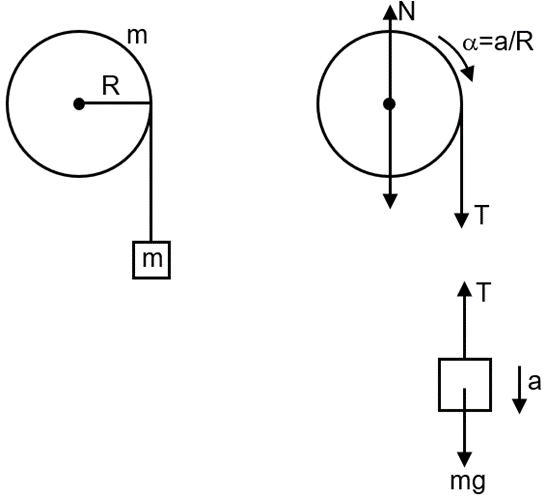A mass m hangs with the help of a string wrapped around a pulley on a frictionless bearing. The pulley has mass m and radius R. Assuming pulley to be a perfect uniform circular disc, the acceleration of the mass m, if the string does not slip on the pulley, is :
mg – T = ma

This problem involves a mass-pulley system where both the hanging mass and the pulley have mass m. The pulley is a uniform disc of radius R. We need to find the acceleration of the mass m when the string does not slip on the pulley.
Step 1: Identify the forces and set up equations
For the hanging mass (m):
The forces acting on it are its weight (mg) downward and the tension (T) in the string upward. Applying Newton's second law:
(Equation 1)
where is the linear acceleration of the mass.
Step 2: Analyze the motion of the pulley
The string does not slip, meaning the pulley rotates. The tension T provides a torque () on the pulley. The torque is given by:
This torque causes an angular acceleration () in the pulley. The relationship between torque and angular acceleration is:
(Equation 2)
where is the moment of inertia of the pulley.
Step 3: Relate linear and angular motion
Since the string does not slip, the linear acceleration of the mass (and the string) is related to the angular acceleration of the pulley by:
(Equation 3)
Step 4: Find the moment of inertia
The pulley is a uniform circular disc with mass m and radius R. The moment of inertia of a disc about its central axis is:
(Equation 4)
Step 5: Combine the equations
Substitute Equation 4 into Equation 2:
Substitute Equation 3 () into the above equation:
Simplify by canceling one R:
(Equation 5)
Step 6: Solve for acceleration (a)
Substitute Equation 5 into Equation 1:
Divide both sides by m:
Bring terms with 'a' to one side:
Therefore, the acceleration is:
Final Answer: The acceleration of the mass m is .
Newton's Second Law for Rotation: The net torque () on a rigid body is equal to the product of its moment of inertia (I) and its angular acceleration ().
Moment of Inertia for a Uniform Disc: For a disc of mass M and radius R rotating about its central axis, .
No-Slip Condition: When a string unwinds without slipping from a pulley, the linear acceleration of the string (a) is related to the angular acceleration of the pulley () by .